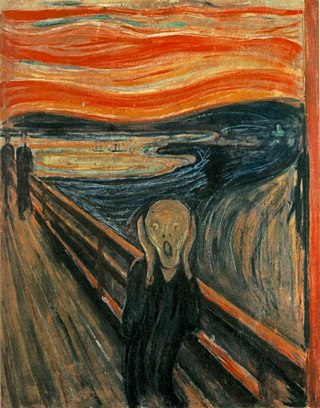
Anxiety is an emotion which is characterised by an unpleasant state of inner turmoil and includes feelings of dread over anticipated events. Anxiety is different from fear in that fear is defined as the emotional response to a present threat, whereas anxiety is the anticipation of a future one. It is often accompanied by nervous behavior such as pacing back and forth, somatic complaints, and rumination.
Differential psychology studies the ways in which individuals differ in their behavior and the processes that underlie it. This is a discipline that develops classifications (taxonomies) of psychological individual differences. This is distinguished from other aspects of psychology in that although psychology is ostensibly a study of individuals, modern psychologists often study groups, or attempt to discover general psychological processes that apply to all individuals. This particular area of psychology was first named and still retains the name of "differential psychology" by William Stern in his book (1900).
Psychophysiology is the branch of psychology that is concerned with the physiological bases of psychological processes. While psychophysiology was a general broad field of research in the 1960s and 1970s, it has now become quite specialized, based on methods, topic of studies and scientific traditions. Methods vary as combinations of electrophysiological methods, neuroimaging, and neurochemistry. Topics have branched into subspecializations such as social, sport, cognitive, cardiovascular, clinical and other branches of psychophysiology.
Neurosis is a term mainly used today by followers of Freudian thinking to describe mental disorders caused by past anxiety, often that has been repressed. In recent history, the term has been used to refer to anxiety-related conditions more generally.

Anxiety disorders are a cluster of mental disorders characterized by significant and uncontrollable feelings of anxiety and fear such that a person's social, occupational, and personal functions are significantly impaired. Anxiety may cause physical and cognitive symptoms, such as restlessness, irritability, easy fatigue, difficulty concentrating, increased heart rate, chest pain, abdominal pain, and a variety of other symptoms that may vary based on the individual.
Post-traumatic stress disorder (PTSD) is a mental and behavioral disorder that develops from experiencing a traumatic event, such as sexual assault, warfare, traffic collisions, child abuse, domestic violence, or other threats on a person's life or well-being. Symptoms may include disturbing thoughts, feelings, or dreams related to the events, mental or physical distress to trauma-related cues, attempts to avoid trauma-related cues, alterations in the way a person thinks and feels, and an increase in the fight-or-flight response. These symptoms last for more than a month after the event. Young children are less likely to show distress, but instead may express their memories through play. A person with PTSD is at a higher risk of suicide and intentional self-harm.

Biofeedback is the technique of gaining greater awareness of many physiological functions of one's own body by using electronic or other instruments, and with a goal of being able to manipulate the body's systems at will. Humans conduct biofeedback naturally all the time, at varied levels of consciousness and intentionality. Biofeedback and the biofeedback loop can also be thought of as self-regulation. Some of the processes that can be controlled include brainwaves, muscle tone, skin conductance, heart rate and pain perception.

Emergency psychiatry is the clinical application of psychiatry in emergency settings. Conditions requiring psychiatric interventions may include attempted suicide, substance abuse, depression, psychosis, violence or other rapid changes in behavior.
Behavioral medicine is concerned with the integration of knowledge in the biological, behavioral, psychological, and social sciences relevant to health and illness. These sciences include epidemiology, anthropology, sociology, psychology, physiology, pharmacology, nutrition, neuroanatomy, endocrinology, and immunology. The term is often used interchangeably, but incorrectly, with health psychology. The practice of behavioral medicine encompasses health psychology, but also includes applied psychophysiological therapies such as biofeedback, hypnosis, and bio-behavioral therapy of physical disorders, aspects of occupational therapy, rehabilitation medicine, and physiatry, as well as preventive medicine. In contrast, health psychology represents a stronger emphasis specifically on psychology's role in both behavioral medicine and behavioral health.
Psychodermatology is the treatment of skin disorders using psychological and psychiatric techniques by addressing the interaction between mind and skin. Though historically there has not been strong scientific support for its practice, there is increasing evidence that behavioral treatments may be effective in the management of chronic skin disorders.
Exposure therapy is a technique in behavior therapy to treat anxiety disorders. Exposure therapy involves exposing the patient to the anxiety source or its context. Doing so is thought to help them overcome their anxiety or distress. Numerous studies have demonstrated its effectiveness in the treatment of disorders such as generalized anxiety disorder, social anxiety disorder, obsessive-compulsive disorder, post-traumatic stress disorder (PTSD), and specific phobias.
Stress-related disorders constitute a category of mental disorders. They are maladaptive, biological and psychological responses to short- or long-term exposures to physical or emotional stressors. The National Institute of Environmental Health Sciences categorizes Obsessive-Compulsive Disorder (OCD) and Post-Traumatic Stress Disorder (PTSD) as stress-related disorders. However, the World Health Organization's ICD-11 excludes OCD but categorizes PTSD, Complex Post-Traumatic Stress Disorder (CPTSD), adjustment disorder as stress-related disorders.

Hans Steiner was an Austrian-born American professor of psychiatry and behavioral sciences, child and adolescent psychiatry and human development at Stanford University, School of Medicine. In 2010 he was awarded Lifetime Distinguished Fellow by the American Psychiatric Association.
Psychological dependence is a cognitive disorder that involves emotional–motivational withdrawal symptoms – such as anxiety or anhedonia – upon cessation of prolonged drug abuse or certain repetitive behaviors. It develops through frequent exposure to certain psychoactive substances or behaviors, which leads to an individual requiring further exposure to avoid withdrawal symptoms, as a result of negative reinforcement. Neuronal counter-adaptation is believed to play a role in generating withdrawal symptoms, which could be mediated through changes in neurotransmitter activity or altered receptor expression. Environmental enrichment and physical activity can attenuate withdrawal symptoms.
Search activity concept (SAC) is a psychophysiological concept that integrates subject's behavior, resistance to stress and deteriorating factors, pathogenetic mechanisms of different mental and psychosomatic disorders, REM sleep functions, brain monoamines activity and brain laterality.

Dennis S. Charney is an American biological psychiatrist and researcher, with expertise in the neurobiology and treatment of mood and anxiety disorders. He is the author of Neurobiology of Mental Illness, The Physician's Guide to Depression and Bipolar Disorders and Molecular Biology for the Clinician, as well as the author of over 600 original papers and chapters. In 2022, he was listed #52 on Research.com's "Top Medicine Scientists in the United States," with an h-index of 194 with 146,109 citations across 651 publications. Charney is known for demonstrating that ketamine is effective for treating depression. Ketamine's use as a rapidly-acting anti-depressant is recognized as a breakthrough treatment in mental illness.

Gary Berntson is an emeritus professor at Ohio State University with appointments in the departments of psychology, psychiatry and pediatrics. He is an expert in psychophysiology, neuroscience, biological psychology, and with his colleague John Cacioppo, a founding father of social neuroscience. His research attempts to elucidate the functional organization of brain mechanisms underlying behavioral and affective processes, with a special emphasis on social cognition.
Thomas Hice Budzynski was an American psychologist and a pioneer in the field of biofeedback, inventing one of the first electromyographic biofeedback training systems in the mid-1960s. In the early 1970s, he developed the Twilight Learner in collaboration with John Picchiottino. The Twilight Learner was one of the first neurotherapy systems.

Richard McNally is an American psychologist and director of clinical training at Harvard University's department of psychology. As a clinical psychologist and experimental psycho-pathologist, McNally studies anxiety disorders and related syndromes, such as post-traumatic stress disorder, obsessive–compulsive disorder, and complicated grief.

Richard Allan Bryant is an Australian medical scientist. He is Scientia Professor of Psychology at the University of New South Wales (UNSW) and director of the UNSW Traumatic Stress Clinic, based at UNSW and Westmead Institute for Medical Research. His main areas of research are posttraumatic stress disorder (PTSD) and prolonged grief disorder. On 13 June 2016 he was appointed a Companion of the Order of Australia (AC), for eminent service to medical research in the field of psychotraumatology, as a psychologist and author, to the study of Indigenous mental health, as an advisor to a range of government and international organisations, and to professional societies.









